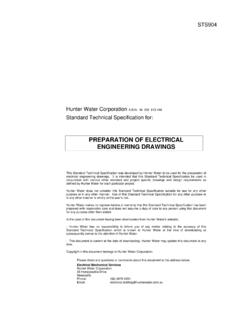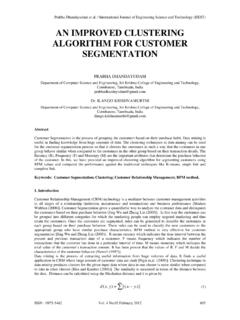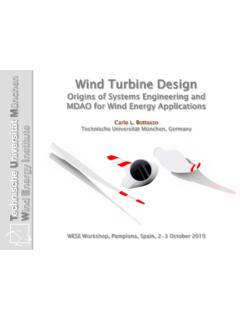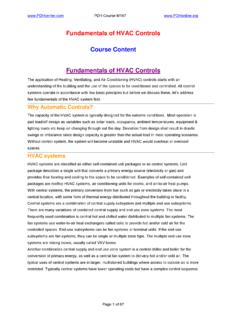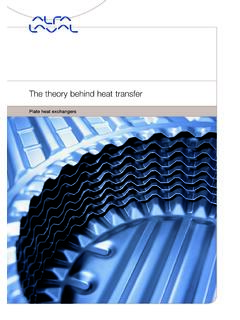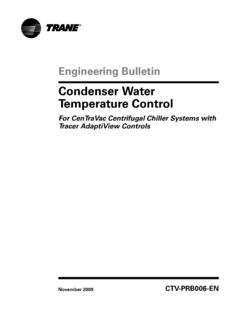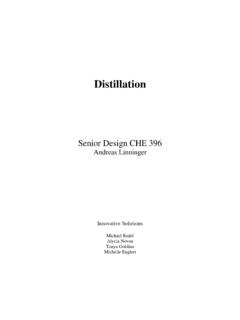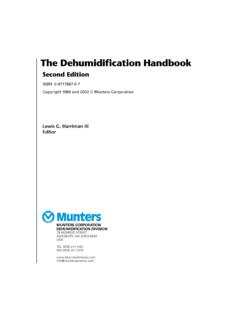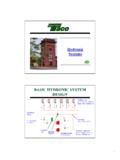Transcription of CHAPTER 7 HEATING, VENTILATING, AND AIR …
1 TM 5-691 7-1 CHAPTER 7 heating , ventilating , and air - conditioning SYSTEMS _____ 7-1. General heating , ventilating , and air - conditioning (HVAC) design The DOD owns and operates many C4 ISR facilities across the nation and abroad, ranging from small computer rooms to large radar facilities. C4 ISR facilities often house computer and communications equipment, radar systems, printers, disk and tape drive, monitors, and system consoles all of which generate substantial amounts of heat. To optimize performance and ensure continued operation, the environment containing the electronic equipment must be maintained within stringent temperature and humidity levels. In addition, the comfort needs of personnel required to operate the equipment must be met and the airborne particulate matter effectively filtered from entering the C4 ISR room airstream.
2 The electronic equipment and personnel must also be protected from electromagnetic pulse (EMP) phenomena, biological contamination, and radiation. In the event of a power failure, a backup system must be available to provide chilled water and cooling air to the water- and air -cooled electronic equipment, respectively, for at least 15 minutes. a. The information present here is not intended to replace the design analysis. Cooling systems must be designed on a case-by-case basis, with consideration given to such factors as cost, location, and mission criticality of the C4 ISR facility. b. With the rapid advancements in state-of-the-art electronics, existing equipment within C4 ISR facilities is constantly being replaced by new, efficient, and more powerful models.
3 As a result, electronic equipment with these facilities is continually relocated to enhance the performance of particular facility functions. In addition to equipment relocation, the volume of equipment inside a C4 ISR building often increases over time. The cooling systems used to maintain environmental conditions with individual C4 ISR rooms must be designed to adapt to these changing circumstances, while still maintaining adequate filtration, EMP protection, and backup. Conventional, commercially available HVAC equipment is generally adaptable to use in C4 ISR facilities whether aboveground or underground. c. General guidelines for design of HVAC systems will be in accordance with TM 5-810-1 Mechanical design heating , ventilating , and air conditioning .
4 Criteria for the design of HVAC systems in humid areas are also addressed in TM 5-810-1. d. Policies, criteria, procedures, and responsibilities for operation, maintenance, repair, and construction of facilities and systems for the efficient and economical management of heating , ventilating , Air conditioning & Refrigeration (HVAC&R) utility services shall be in accordance with Army Regulation (AR) 420-49, Utility Services. e. All mechanical systems shall have the capability of being remotely controlled from the control room. Upon a loss of normal electrical power, HVAC systems serving mission critical areas or systems shall be powered from the emergency generators. HVAC equipment and systems whose loss of power would impact the facility mission ( , 15-minute chilled water backup pump, computer room air- conditioning units, controls, and Chemical, Biological, and Radiological [CBR] blowers) will be operated from the UPS system until the facility generators can restore power.
5 TM 5-691 7-2 f. The design conditions for the indoor and/or outdoor HVAC systems will be in accordance with the design guidance in TM 5-810-1. design conditions for electronic equipment areas will deviate from those required for comfort conditioning only to the extent required to support the equipment to be housed within the area. 7-2. heating , ventilating , and air conditioning (HVAC) equipment reliability and survivability HVAC equipment installed in C4 ISR facilities shall meet the following reliability and survivability goals. a. Reliability. In mission critical facility applications, mechanical components, such as computer room type air- conditioning units, chillers, and mechanical pumps, shall have N + 2 redundancy, where N is the minimum number of units required and 2 is the required number of redundant units.
6 If the mission is less critical, one extra unit (N + 1) may be adequate. Three factors dictate the level of redundancy required: (1) critical nature of the mission, (2) equipment reliability, and (3) equipment cost. The authority having jurisdiction and the design engineer(s) shall assess these factors when determining the level of redundancy required for a specific C4 ISR facility. Redundant units will be designed to automatically start and maintain the load should the operating unit fail. Due to the high degree of reliability required for computer cooling systems, redundant components on the control system(s) may be justified. b. Survivability. HVAC equipment installed in C4 ISR facilities will be of such design or otherwise protected to withstand seismic effects as well as shock (ground motion) and overpressure effects of weapons.
7 A detailed dynamic analysis will be made of the supporting structure(s) of the HVAC equipment to evaluate the magnitude of motion and acceleration established at the mounting points for each piece of HVAC equipment. Where accelerations exceed the allowable limit of equipment available, the equipment will be mounted on shock isolation platforms. The design will include, where feasible, certain features which will enhance the survivability of the HVAC equipment. For example, double inlet fans and double suction pumps are more likely to withstand shock forces generated by ground motion with the fan wheel and impeller supported on both sides. Conversely, single inlet fans and pumps with overhung wheels and impellers should not be used in C4 ISR installations unless they are mounted on shock isolated platforms.
8 7-3. Mission critical areas and control room (CR) Mission critical areas such as command centers, radar installations, and similar areas will generally contain computers and ancillary equipment which are sensitive to extremes of temperature, humidity, and the presence of duct. Computer and electronic equipment will deviate from indoor design conditions for comfort cooling, including temperature, humidity, and level of filtration, to the extent required to support the computers and equipment housed within the area. The HVAC system supporting the mission critical areas and systems shall be dedicated to those areas and systems and shall not be shared with other non-mission areas. a.
9 Air handling equipment. Computer room air- conditioning units located within the mission critical areas of the C4 ISR facility are typically chilled water type units served by a liquid chilling system. Where practical, divide the area's cooling load between two or more smaller units to satisfy the required cooling capacity. This will generally reduce the energy consumption at partial cooling loads and will also increase overall system reliability. The use of multiple computer room type air- conditioning units ( , N + 2 rule) provides redundancy required for these facilities. b. Air distribution systems. A variety of methods can be used to distribute conditioned air in electronic equipment areas.
10 TM 5-691 7-3 (1) Most electronic equipment rooms use a raised floor as the underfloor plenum supply air system. Perforated floor panels are used with the underfloor plenum for providing good flexibility in accommodating potential relocation of equipment. The air distribution pattern can be modified by simply exchanging standard floor panels with perforated floor panels to satisfy the changing locations of concentrated cooling loads. The number and size of supply air outlets in the raised floor should be based on delivering 80 percent of the total supply air. The remaining 20 percent of the supply air should be routed to the room via cable cutouts in the raised floor. Raised floors using underfloor plenum and perforated floor panels can also handle load expansion by accommodating additional air handling units.
